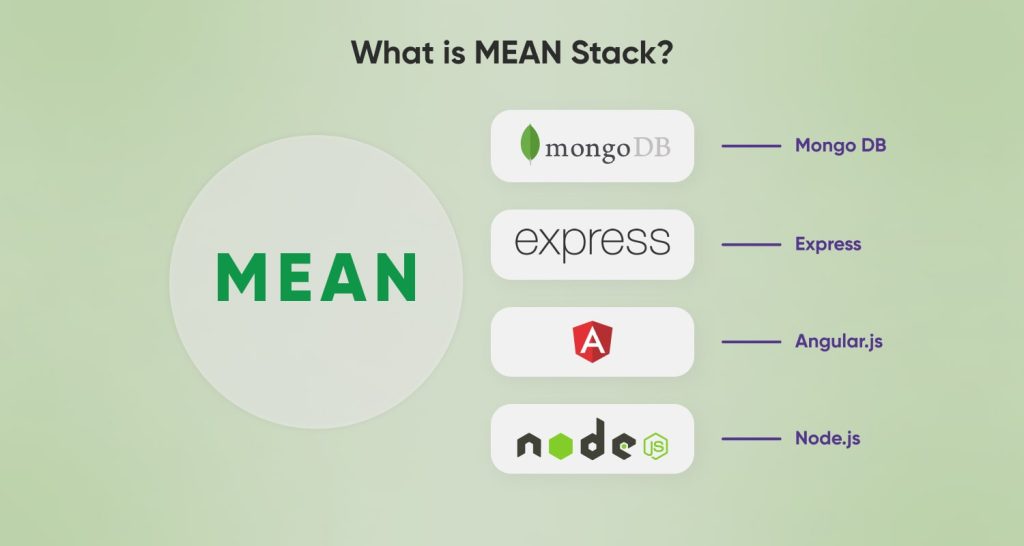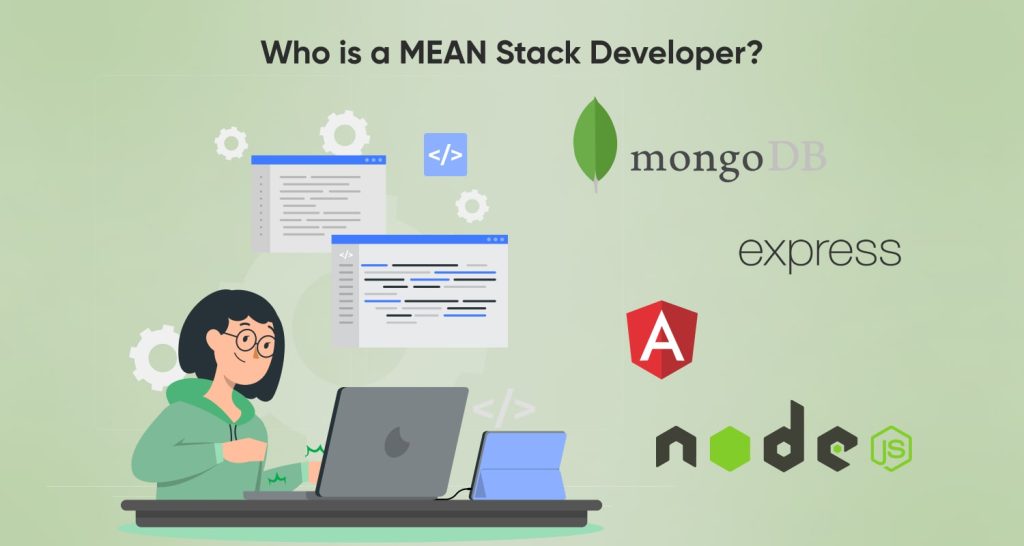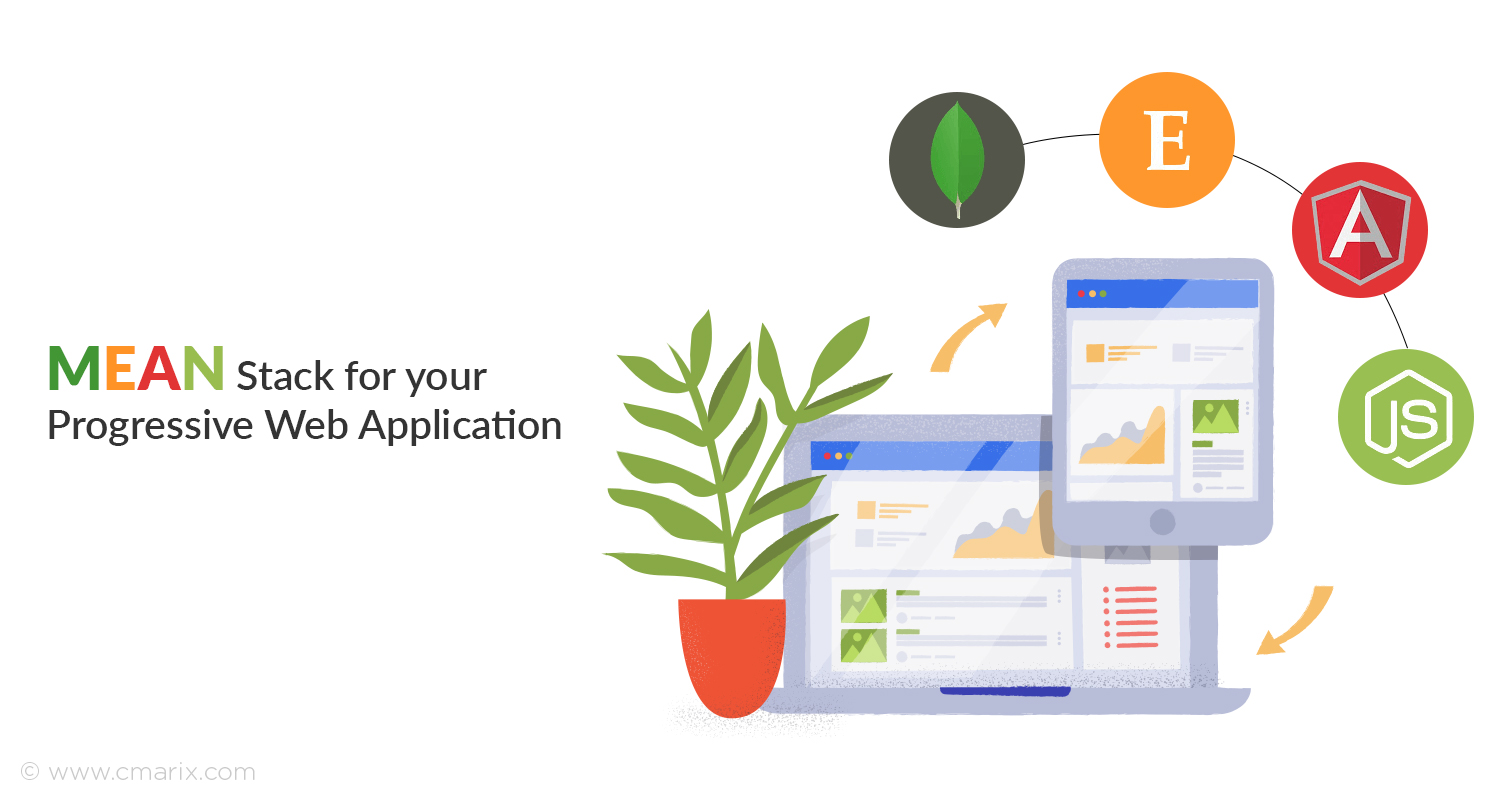In the current digital age, businesses want to create scalable web and mobile applications ready for cloud deployment. One such framework that facilitates the creation of applications while producing superior results is the MEAN stack.
The MEAN technology stack combines cutting-edge technologies like MongoDB, Express, AngularJS, and Node.js, making it perfect for creating creative applications. Hire a MEAN stack developer to create apps like YouTube, Facebook, Netflix, Tumblr, Forbes, Instagram, and many more.
Let’s examine the MEAN Stack frameworks specifics and how they apply to your company.
What is the MEAN Stack?

The MEAN stack is a powerful and popular web development technology stack that stands for MongoDB, Express.js, AngularJS, and Node.js. It is a full-stack JavaScript solution that is widely used to develop dynamic, scalable, and feature-rich web applications. The MEAN stack is a popular choice for building web applications because it allows developers to use a single language, JavaScript, both on the server and the client side.
MEAN stack development typically involves using MongoDB as the database, Express.js as the server-side web application framework, AngularJS as the front-end JavaScript framework, and Node.js as the server-side runtime environment. MEAN stack web development is known for its flexibility and agility, which enables developers to create scalable and robust applications that can handle large amounts of data and traffic.
One of the main advantages of using the MEAN stack for web development is its open-source nature, which means that developers can easily customize and extend the framework as needed. Additionally, MEAN stack development is often preferred because it allows for rapid development and deployment of web applications. The MEAN stack framework provides a set of tools and libraries that enable developers to create web applications quickly and efficiently, saving them time and effort.
Overall, the MEAN stack is a versatile and powerful web development technology that is well-suited for building robust, scalable, and feature-rich web applications. Its flexibility, agility, and open-source nature make it a popular choice among developers, and its set of tools and libraries allow for rapid development and deployment of web applications. Now that you know “what is the MEAN Stack”, let us study who can be a MEAN stack developer.
Who is a MEAN Stack Developer?

A MEAN Stack developer is a professional who specializes in building web applications using the MEAN stack technology. They have expertise in the MongoDB, Express.js, AngularJS, and Node.js technologies and use their skills to develop, test, and deploy web applications. MEAN Stack developers are in high demand as many businesses are opting for MEAN Stack consulting services to build scalable and robust web applications.
MEAN Stack developers are responsible for implementing best practices for web development using the MEAN stack. They ensure that the code is optimized for performance, security, and scalability. They also maintain high coding standards and adhere to industry best practices to ensure that the web application is reliable and efficient. MEAN Stack developers stay updated with the latest trends in the MEAN Stack technology and implement new features and enhancements as needed to keep the web application up-to-date.
MEAN Stack developers are highly skilled professionals who are proficient in MEAN technology. They implement best practices for web development using the MEAN stack, ensuring that the web application is optimized for performance, security, and scalability. They play a critical role in developing high-quality web applications for businesses and are in high demand for MEAN Stack consulting services.
What is the Future of Mean Stack Developer?
Being a Mean stack engineer is a highly sought-after and difficult profession. Therefore, if you are willing to work on a diverse skill set and have experience working with a variety of coding languages and applications, you will succeed as a MEAN stack developer. After getting experience as a mean stack developer, you can easily advance into the field of application architecture (technical architecture).
If you have understood what is the MEAN Stack, you should also know what are its components.
4 Components of MEAN Stack
| Component | Definition | Features | Importance | When to Use |
| MongoDB | A NoSQL document-oriented database system | Schemaless, flexible data model, high performance, automatic sharding, easy scalability | Stores and retrieves data for the application, supports dynamic queries, high availability, and easy integration with Node.js | When handling large amounts of unstructured data and need scalability and flexibility in data storage |
| Express JS | A web application framework for NodeJS | Simple and minimalistic, robust set of features, middleware support, scalable, flexible | Provides ExpressJS development services structure for building web applications, handles HTTP requests and responses, and supports server-side | When building web applications with Node.js that require efficient routing, middleware support, and scalability |
| AngularJS | A front-end JavaScript framework for building dynamic web applications | A front-end JavaScript framework for building dynamic web applications Two-way data binding, dependency injection, templates, directives, filters, testing support | Enables dynamic rendering of web pages, handles user inputs and interactions, and provides a rich set of features for building complex web applications | Hire dedicated Angular developer to build complex and interactive web applications that require efficient data binding, modular code organization, and powerful features |
| NodeJS | A server-side JavaScript runtime environment. | Event-driven, non-blocking I/O, scalable, efficient, large community support. | Enables server-side programming in JavaScript, supports building scalable and high-performance web applications, and provides a rich set of libraries and modules for web development. | When building server-side applications, real-time web applications, and scalable web applications with high performance and efficiency. |
The MEAN Stack components consist of MongoDB for data storage, Express JS for building web applications, AngularJS for building dynamic front-end applications, and NodeJS development services for server-side programming. Each component offers a unique set of features and benefits that make it well-suited for building different types of web applications. Understanding the roles of each component is crucial for effective MEAN Stack development.
What is the MEAN Stack Architecture – Detailed Explanation
MEAN stack architecture is a software architecture that is used to build web applications using the MEAN stack technology, which consists of MongoDB, Express JS, AngularJS, and NodeJS. This architecture provides a full-stack solution for web development and is known for its flexibility, efficiency, and scalability.
As an example, let’s consider the architecture of an e-commerce web application built using the MEAN stack. The database for the application is built using MongoDB, which provides a schema-less, flexible data model that can easily store and manage data related to products, users, orders, and other entities.
The server side of the application is built using NodeJS and ExpressJS, which handle the routing, middleware, and other server-side programming tasks. This allows for the creation of efficient and scalable web applications, which can handle a high volume of traffic and requests.
The front end of the application is built using AngularJS, which provides a powerful set of features for building dynamic and interactive user interfaces. It enables the creation of a responsive and engaging user interface that can handle user input and provide real-time updates.
Overall, MEAN stack architecture enables the creation of complex and scalable web applications with a consistent and efficient workflow. Businesses can hire ExpressJS developers and NodeJS development services to build robust and efficient web applications. MEAN stack web development is a popular choice for businesses that require scalable and efficient web applications, and the architecture provides a set of best practices and guidelines for building such applications.
You may like this: Benefits of Using MEAN Stack for Developing PWA
Advantages of MEAN Stack
Here are 5 key advantages of using the MEAN stack for web development:
One language throughout the stack: MEAN stack uses JavaScript throughout the entire stack, from the front end to the back end. This makes it easy for developers to work on all aspects of the application without needing to learn multiple programming languages. This also allows for efficient communication between team members and reduces the time and cost required for the development.
Flexibility and Scalability: The MEAN stack is highly flexible and scalable, making it easy to add or remove components as needed. This flexibility also makes it easier to scale the application and adapt to changing business needs.
Open Source: All components of the MEAN stack are open source, which means they are available for free and can be easily customized and modified. This reduces the cost of development and allows developers to build applications quickly and efficiently.
Robust Set of Tools and LibrariesThe MEAN stack comes with a rich set of tools and libraries that can be used to build complex and feature-rich web applications. This allows developers to leverage pre-existing code and focus on building custom features and functionality for their applications.
Rapid prototyping and development: The MEAN stack enables rapid prototyping and development of web applications. The components are designed to work seamlessly together, and the use of JavaScript throughout the stack allows for fast development and debugging.

MEAN Stack Example
If you have known in the above blog, what is the MEAN Stack, you must have also thought of an example in your mind.
However, the best example of an application built using the MEAN stack is LinkedIn. LinkedIn is a social media platform for professionals that allows users to connect with others in their industry, share their experiences and skills, and find job opportunities.
LinkedIn’s website is built using the MEAN stack, with MongoDB used for storing user data, Express JS and NodeJS for the server-side processing, and AngularJS for the front-end user interface.
The use of the MEAN stack has allowed LinkedIn to build a scalable and efficient platform that can handle a high volume of traffic and user interactions. It also provides a seamless user experience with a fast and responsive interface that allows users to easily search for job opportunities, connect with others in their industry, and build their professional network.
You may like this: MEAN Stack Or MERN Stack for Front-End Development
How Can CMARIX Help You Build Feature-rich MEAN Stack App?
CMARIX is a leading mobile and web app development company with expertise in MEAN stack development. Their team of experienced developers can build feature-rich applications using the MEAN stack, which includes MongoDB, Express JS, AngularJS, and NodeJS. They follow an agile development methodology that allows them to deliver high-quality solutions in a timely and efficient manner.
One of the key advantages of working with CMARIX is their ability to provide customized solutions to meet the specific needs of your business. They work closely with clients to understand their business requirements and build solutions that are tailored to their needs. Whether you need a simple web application or a complex enterprise-level solution, CMARIX has the expertise to deliver high-quality and efficient solutions using the MEAN stack.
Conclusion
A future-looking and modernized technology in the web server industry would be MEAN Stack. The stack is used by MEAN businesses to develop innovative and one-of-a-kind apps. The powerful capabilities of the MEAN stack could make programming extremely fast and easy. By avoiding the necessity of updating a website for each server, as most traditional application forms do, it also makes use of the capabilities of current single-page applications. There are a few justifications for why MEAN Stack is gaining popularity in software development.
Get in touch with us if you’re interested in learning how simple it would be to design and launch a cloud platform using only a MEAN stack. We have a basic guide for integrating modern software into an application framework.
Frequently Asked Questions
Is Mean Stack Good for Beginners?
Yes, MEAN stack can be a good starting point for beginners as it is easy to learn and has a vast community of developers to help them. The MEAN stack provides a clear structure and comprehensive documentation that makes it easy for beginners to learn and get started. Moreover, it is an open-source technology that is freely available, making it accessible to anyone who wants to learn it.
What skills are required for MEAN Stack Developer?
A MEAN Stack Developer should have a good understanding of JavaScript, HTML/CSS, and web development concepts. They should also have expertise in MongoDB, Express JS, AngularJS, and NodeJS. Additionally, they should be familiar with RESTful API development, web security, and version control systems like Git.
Is MEAN stack in demand?
Yes, MEAN stack is in high demand as it is a popular technology stack for building modern web applications. It is widely used by startups, small businesses, and large enterprises to build scalable and efficient applications. The MEAN stack has a vast community of developers, and its popularity is expected to grow in the future.
Is Mean Stack Better Than Full Stack?
MEAN stack is a type of full stack, and both have their unique advantages and disadvantages. Full stack development includes front-end and back-end development, while MEAN stack development focuses on building applications using MongoDB, Express JS, AngularJS, and NodeJS. Whether MEAN stack is better than full stack depends on the specific project requirements and the expertise of the developer.
MEAN stack is a good option for building modern web applications, while the full stack is suitable for building a wider range of applications, including mobile and desktop applications.






